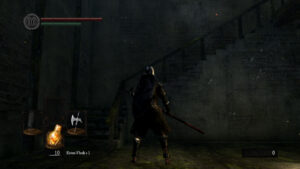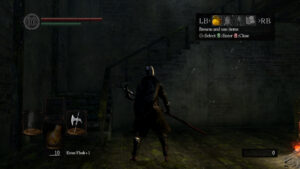Dark Souls: Bonfires
Apparently Hidetaka Miyazaki, the director of Dark Souls, has said that the bonfires dotted around the lands are meant to symbolize hope. They’re sites of light and warmth kindled by the hero in an otherwise relentlessly dark and dangerous landscape. I have doubts about their efficacy as metaphor, but they’re definitely one of the most mechanically crucial things in the game. They serve as checkpoints, but simply calling them that sells them short. They’re more like base camps, where you not only refill your health but level up, perform maintenance, upgrade your equipment, and prepare spells. I’m told that you eventually get some kind of fast travel between them, but I’m not there yet.
Still, their greatest impact on the gamefeel is simply as checkpoints. But that means something very different in a game based on free exploration than it does in a more linear game, and the way Dark Souls treats death makes it more crucial still. It all has to do with Souls. “Souls” doesn’t mean what it sounds like; it’s just a sort of combination of experience points and currency. You get them by defeating enemies, and you spend them to either level up or to buy stuff from vendors. And that’s often a difficult choice. Levels cost a lot — the value of “a lot” increases, but the game is balanced such that it takes a considerable time to level up by grinding for Souls in the areas you can handle easily at your current level.
Now, when you die — and you die a LOT — you respawn at the last bonfire you touched, without your accumulated Souls. The Souls are recoverable, dropped in a green-glowing pile at the spot where you died (or, if you died by falling off a cliff or something, the last place you stood on the ground — a welcome mercy!) But you only get one such drop spot at a time. If you die again, your old Souls are lost. Crucially, there’s no way to “bank” unspent Souls. Anything yet unspent is always at risk, and the farther you are from a bonfire, the greater that risk: if the drop spot is on the far side of a tough fight, you might just resign yourself to the loss. This is where the sense of tension comes from in exploring new territory. It’s not the fear of death itself. Death is nothing. You can’t die for real. It’s the fear of losing your Souls.
And that’s why finding a new bonfire is such a big deal. Suddenly, the sense of risk in the surrounding area is drastically decreased! The feeling is less one of hope than of relief.
Now, this game isn’t exactly designed hub-and-wheel, but the closest thing it has to a hub is the Firelink Shrine, the first area after the tutorial, which provides access to three other zones from the beginning and shortcuts that can be opened to a couple others. It’s got the most prominently-presented bonfire of them all, and the game encourages you to think of it as home by making it the place that vendors and other helpers go after you rescue them from dangers. At a certain point in the story, the bonfire there goes out and can’t be rekindled, or at least not immediately, and it’s a fairly big moment. I don’t think this is the start of a trend, but it makes me think: What if other bonfires started going out? That makes the “hope” interpretation more plausible again. Not so much that it makes me feel hope, but that its loss would make me feel a loss of hope.
 Comments(0)
Comments(0)
